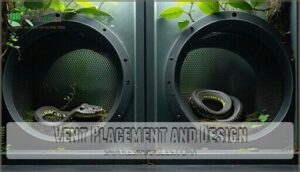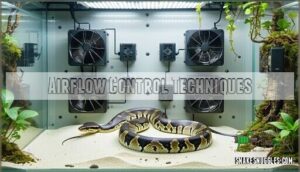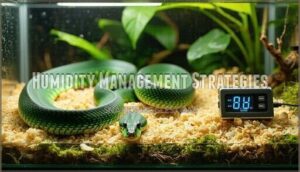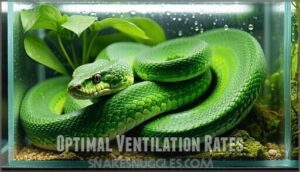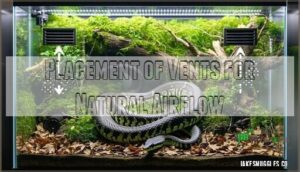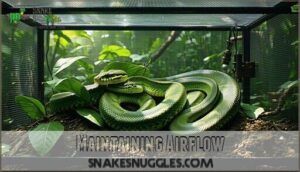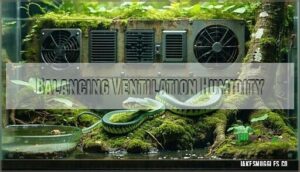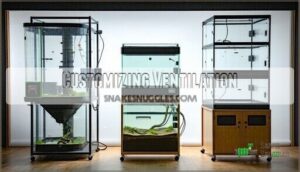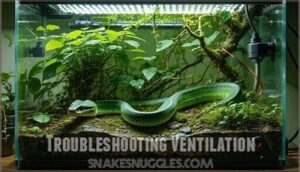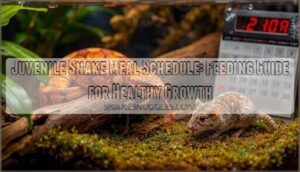This site is supported by our readers. We may earn a commission, at no cost to you, if you purchase through links.
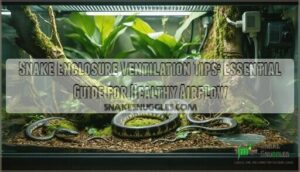
Snake enclosure ventilation tips start with natural air circulation – place vents low on the cool side and high on the warm side. This creates a gentle breeze as hot air rises and cool air enters below.
Without good ventilation your snake faces respiratory infections and poor temperature control. The right setup prevents stagnant air that traps moisture and bacteria.
Your enclosure needs enough air changes to stay fresh but not so much that humidity drops too low. Different snake species have unique needs based on their natural habitats.
Getting ventilation right involves more than just poking holes in your tank.
Table Of Contents
- Key Takeaways
- Ventilation Basics
- Choosing Ventilation Systems
- Optimal Ventilation Rates
- Designing Ventilation Openings
- Maintaining Airflow
- Balancing Ventilation Humidity
- Temperature Regulation
- Customizing Ventilation
- Troubleshooting Ventilation
- Frequently Asked Questions (FAQs)
- What to put on the bottom of a snake enclosure?
- How to keep mold out of a snake enclosure?
- What not to put in a snake enclosure?
- Do snakes need ventilation?
- How do I choose a snake enclosure?
- How do you optimize airflow in a snake enclosure?
- Can you put a snake enclosure in a laundry room?
- How do I keep my snake enclosure cool?
- How to ventilate a terrarium?
- How do I make my snake enclosure humid?
- Conclusion
Key Takeaways
- Position vents strategically – You’ll need to place intake vents low on the cool side and exhaust vents high on the warm side to create natural airflow that prevents stagnant air and respiratory infections.
- Balance airflow with humidity – You must maintain 6-8 air changes per hour while keeping humidity levels appropriate for your snake’s species, as too much ventilation will dry out the enclosure.
- Monitor and maintain your system – You should check vents weekly for blockages, clean components monthly, and use digital monitors to track air quality indicators before problems affect your snake’s health.
- Customize for your setup – You’ll need different ventilation approaches depending on whether you’re using glass terrariums, plastic tubs, or wooden vivariums, with each material requiring specific hole sizes and placement patterns.
Ventilation Basics
Your snake’s health depends on proper ventilation that keeps fresh air flowing through the enclosure.
Good airflow prevents dangerous respiratory infections and helps you maintain the right temperature and humidity levels your snake needs to thrive, which is crucial for its overall health.
Importance of Airflow
Proper ventilation serves as your snake’s lifeline to peak health. Fresh air circulation prevents stagnant conditions that harm respiratory systems and overall well-being.
- Respiratory Health: Clean airflow removes harmful gases and maintains oxygen levels
- Temperature Regulation: Air movement helps distribute heat evenly throughout the enclosure
- Humidity Control: Ventilation prevents excessive moisture buildup in critical areas
- Mold Prevention: Good snake enclosure air flow stops dangerous fungal growth
Preventing Respiratory Infections
Stagnant air creates breeding grounds for harmful bacteria and fungi that attack your snake’s respiratory system.
Fresh air saves lives – stagnant air kills snakes through respiratory disease.
Snake enclosure ventilation prevents these pathogens from building up. Recognizing symptoms like mouth breathing or wheezing helps catch infections early.
Quarantine protocols and disinfecting enclosures stop disease spread. Proper ventilation supports reptile health by maintaining clean air circulation throughout the habitat, which is crucial for preventing the buildup of harmful bacteria and pathogens.
Regulating Temperature and Humidity
You control your snake’s environment like a thermostat controls your home.
Proper snake enclosure ventilation creates stable conditions that keep your pet healthy.
- Heating Methods work with airflow to distribute warmth evenly
- Thermal Gradients develop when cool air enters and warm air exits
- Humidity Control prevents condensation through steady air movement
- Misting Systems need ventilation to avoid oversaturation
- Monitoring Equipment tracks temperature and moisture levels accurately
Choosing Ventilation Systems
You’ll need to carefully select the right ventilation system for your snake’s specific needs and enclosure type.
The key is finding the perfect balance between adequate airflow and maintaining proper temperature and humidity levels, which is crucial for your snake’s well-being, and proper temperature.
Vent Placement and Design
Strategic vent location creates proper airflow patterns in your snake’s home.
Place intake vents low on one side and exhaust vents high on the opposite side. This setup uses natural convection currents.
Hole size should match your enclosure volume – too small restricts airflow while oversized openings dump humidity. Fine mesh types prevent escapes without blocking air circulation.
DIY vents work well for custom setups.
Airflow Control Techniques
Managing airflow in your snake tank requires smart baffle placement to prevent direct drafts on your pet.
Fan integration helps maintain consistent reptile enclosure ventilation without creating harsh currents. Control airflow direction by positioning intake vents low and exhaust vents high.
Understanding pressure dynamics guarantees proper reptile tank ventilation. Different diffuser types spread air evenly throughout the enclosure for adequate ventilation.
Adequate ventilation often requires specialized enclosure components, which is crucial for maintaining a healthy environment, emphasizing the importance of proper reptile tank ventilation.
Humidity Management Strategies
Balanced humidity creates the perfect environment for your snake’s health and comfort.
Position water bowls strategically to increase moisture levels naturally. Choose substrate that retains appropriate humidity while allowing adequate ventilation.
Monitor with a hygrometer and adjust misting frequency based on your snake’s shedding needs. This approach maintains ideal snake enclosure humidity without compromising reptile enclosure ventilation systems, ensuring perfect environment and adequate ventilation.
Optimal Ventilation Rates
Getting the right airflow rate isn’t about guessing – it’s about understanding what your snake actually needs.
You’ll want to calculate the proper air changes per hour based on your enclosure size and your specific species requirements.
Factors Affecting Ventilation Requirements
Your snake’s ventilation needs depend on several key factors.
Snake size and species needs matter most – larger snakes produce more waste gases requiring better airflow.
Enclosure size affects air circulation patterns.
Substrate type influences moisture retention, and dense bedding blocks airflow and needs compensation.
Ambient humidity levels in your room impact snake tank ventilation requirements, and tropical species need less ventilation for reptiles than desert dwellers to maintain proper reptile enclosure humidity, which is crucial for reptile enclosure.
Calculating Air Changes Per Hour
You’ll need to determine your enclosure’s ACH calculation by dividing total airflow per hour by enclosure volume.
Most snake tank ventilation systems work best at 6-8 ACH for balanced air quality.
Measure your setup’s airflow using ventilation formulas that account for fan capacity and vent size.
This airflow measurement guarantees proper snake respiration while maintaining reptile enclosure humidity levels effectively, which is crucial for reptile enclosure health.
Adjusting Ventilation for Different Snake Species
Different snake species need specialized ventilation for ideal health. Species-Specific Needs vary dramatically between desert and tropical reptiles. Humidity Requirements dictate your air flow setup.
Consider these ventilation adjustments:
- Arid species (corn snakes) – 8-12 ACH prevents humidity buildup
- Tropical species (ball pythons) – 4-8 ACH maintains moisture levels
- Arboreal Ventilation requires cross-flow for respiratory health
- Burrowing Species need gentle air circulation to avoid substrate drying
Shedding Considerations may require temporary humidity boosts with reduced airflow.
Designing Ventilation Openings
When you’re designing ventilation openings for your snake’s home, proper placement and sizing create the airflow patterns your pet needs to stay healthy.
Strategic vent positioning combined with the right hole dimensions and protective screens guarantees fresh air circulation while keeping your snake secure inside its enclosure.
Placement of Vents for Natural Airflow
Strategic positioning maximizes reptile enclosure air flow through natural convection currents.
Install vents at your enclosure’s bottom (cool end) and top (warm end) to harness natural pressure differences. Cross-ventilation is essential for adequate air exchange.
| Vent Location | Purpose | Airflow Effect | Snake Health Benefit |
|---|---|---|---|
| Bottom/Cool End | Cool air intake | Creates upward flow | Prevents stagnant air |
| Top/Warm End | Hot air exhaust | Completes circulation | Reduces respiratory risks |
| Back wall strips | Cross-ventilation | Horizontal movement | Even air distribution |
| Opposite corners | Maximum exchange | Diagonal patterns | Ideal snake care |
This ventilation for snakes setup uses physics—warm air rises while cool air sinks, creating automatic airflow patterns throughout your snake enclosure setup.
Size and Shape of Ventilation Holes
Typically measure one inch in diameter for ideal reptile enclosure air flow. Circular holes work best for most snake enclosure setup needs.
You’ll want 3-4 holes at each end for proper ventilation for snakes. Square openings also work well.
Total hole placement should provide 6-12 square inches of ventilation area. Material choice affects hole diameter – drill 9-12mm holes in plastic enclosures.
Number of holes matters more than individual shape impact for snake health and snake enclosure maintenance.
Using Mesh Screens for Safety
Proper screens turn ventilation holes into safe passages while blocking escape routes. Metal mesh works best near heat sources due to its strength and heat resistance.
Here’s your screen selection guide:
- Mesh Material: Choose fly wire or metal mesh for durability and airflow
- Screen Security: Install firmly to prevent gaps or loose edges
- Escape Prevention: Select hole sizes smaller than your snake’s head
- Injury Prevention: File smooth any sharp mesh edges after cutting
- Cleaning Mesh: Remove screens monthly for thorough reptile enclosure maintenance
This setup maintains excellent reptile enclosure ventilation tips while keeping your snake secure inside. Ideal airflow requires understanding recommended ventilation rates for your snake’s specific needs.
Maintaining Airflow
You’ll need to actively monitor your snake’s environment to guarantee proper airflow stays consistent over time. Regular maintenance of your ventilation system prevents problems before they affect your snake’s health.
Monitoring Air Quality Indicators
Digital monitors track ammonia levels and humidity sensors in your reptile enclosure setup.
WiFi-enabled devices alert you when airflow patterns change or temperature monitoring shows unsafe readings.
These tools prevent mold prevention issues by catching problems early, allowing you to adjust settings customization for your specific reptile care needs.
Smart monitoring beats guesswork every time, and owners can now utilize IoT-enabled sensors for real-time environmental monitoring to ensure the best care for their reptiles, making reptile care more efficient and effective with smart monitoring.
Cleaning and Maintaining Ventilation Components
Weekly cleaning keeps your snake’s ventilation system running smoothly and prevents health problems. Clean water bowls and surfaces stop bacteria buildup. Steam-clean vents to destroy harmful pathogens with high heat.
Many owners purchase a specialized enclosure filter for their snake’s habitat.
- Filter Replacement: Change air filters monthly to maintain proper airflow in your reptile enclosure setup
- Fan Maintenance: Clean fan blades weekly and check for dust buildup that reduces efficiency
- Mold Prevention: Use chlorhexidine disinfectants on surfaces and dry completely before returning snakes
- Component Inspection: Check all vents and screens for damage during your regular reptile care routine
Addressing Ventilation Obstructions
Check vents daily for debris buildup and shed skin that blocks airflow. Like playing snake game where wall avoidance keeps you moving, blocked vents stop air circulation dead.
Clear obstructions with tweezers or soft brushes. Install mesh screens to prevent future clogs while maintaining proper ventilation.
Proper ventilation guarantees stable environmental conditions. Regular filter maintenance prevents mold growth and airflow reduction, ensuring proper ventilation.
Balancing Ventilation Humidity
You’ll need to balance fresh air intake with moisture retention to create the right humidity zones for your snake’s health.
Strategic ventilation placement lets you maintain proper humidity levels while preventing stagnant air that can lead to respiratory problems, which is crucial for preventing stagnant air and maintaining proper humidity levels.
Creating Humidity Gradients
Good airflow sets the stage for smart humidity management. You can create humidity zones that let your snake choose its preferred moisture levels like adjusting game settings in Snake Game.
Place substrates strategically and use water bowls to build gradients. This approach allows for customizable environments that cater to the snake’s needs.
- Position cypress mulch in basking areas for moderate moisture retention
- Add humid hides with damp moss for high-humidity microclimates
- Keep substrate choice varied across temperature zones for customizable gameplay-style control
Using Misting Systems Effectively
Automated misting systems boost enclosure humidity by simulating rainfall cycles.
Set schedules for every 2-3 hours using quality water and appropriate nozzle types.
Monitor humidity sensors to prevent over-saturation.
Regular system maintenance keeps components working properly.
Like adjusting game settings for customizable gameplay in snake game modes, fine-tune your misting parameters.
Strategic timing creates ideal conditions without waterlogging substrates.
You can buy a complete mister system for your reptile’s enclosure, ensuring a well-maintained environment with complete concepts in mind.
Implementing Humidity Retention Techniques
Smart substrate choice forms the backbone of humidity retention in your snake’s home. Cypress mulch and coconut fiber act like tiny sponges that slowly release moisture into the air.
Here are three proven techniques:
- Water Bowls – Place large shallow dishes on the warm side for steady evaporation
- Live Plants – Add pothos or snake plants for natural humidity through transpiration
- Sealed Vents – Block small sections of mesh tops using reptile-safe materials
Just like customization options in a snake game offer different game modes for accessibility, your enclosure needs varied moisture zones.
Monitor misting frequency to prevent oversaturation.
Temperature Regulation
Temperature regulation in your snake’s enclosure relies on proper ventilation to create the right thermal environment.
You’ll need to manage heat dissipation and establish thermal gradients while using cool air intake to maintain ideal temperatures, ensuring a proper balance for your snake’s health.
Managing Heat Dissipation
Your snake’s enclosure can turn into a sauna without proper heat dissipation. Heat source placement affects airflow patterns and temperature control.
Position vents above heat sources to let hot air escape naturally. This prevents substrate heat retention that creates dangerous hot spots.
Enclosure size impact matters too – larger spaces need more vents for airflow optimization. Use cooling methods like fans during summer months.
Think of it like game speed control in snake games where difficulty increases without proper heat management.
Creating Thermal Gradients
Well-designed ventilation creates thermal gradients that help your snake regulate body temperature naturally.
Place warm-side vents above Heat Sources to direct heated air out while cool-side vents bring fresh air to the Cool Zone.
Your Basking Spot should reach species-specific temperatures while the gradient spans 75°F–90°F.
A proper temperature gradient is vital for digestion and overall health.
Regular Gradient Measurement guarantees proper thermal zones that reduce stress and promote healthy behaviors.
Utilizing Cool Air Intake
Position intake vents low on the cool side to draw fresh air naturally through convection.
This intake placement creates steady airflow direction that supports your temperature gradient without causing drafts.
Proper cooling methods involve matching intake size to exhaust vents.
Fresh air intake reduces humidity impact while maintaining snake control over thermal zones like a strategic snake game, which involves understanding the importance of thermal zones.
Customizing Ventilation
Different enclosure materials need specific ventilation approaches to maintain healthy airflow for your snake.
You’ll customize your ventilation strategy based on whether you’re working with glass terrariums, plastic tubs, wooden vivariums, or rack systems to ensure a healthy environment for your pet.
Glass Terrariums Vs. Plastic Enclosures
Between these enclosure types, you’ll notice key differences that affect your snake’s health.
Glass terrariums lose humidity faster than plastic due to increased ventilation rates.
Plastic enclosures provide stable moisture levels and better heat retention.
Material durability varies – glass offers classic aesthetic appeal but weighs more.
Cost analysis shows plastic wins for budget-conscious players.
Both work for computing temperature setups with proper grid size planning and offer a way to achieve better heat retention.
Ventilating Wooden Vivariums
Wooden vivariums need smart airflow planning to prevent wood rot and maintain healthy conditions.
Choose hardwoods over softwoods for durability.
Proper sealing techniques protect against moisture damage while allowing necessary ventilation.
Consider your snake’s needs like a careful game design – every detail matters for the best gaming experience.
DIY Vents for Wooden Enclosures:
- Strategic placement – Install vents on opposite sides to create cross-ventilation that prevents stagnant air pockets
- Adjustable sizing – Use removable panels or sliding covers to control airflow direction based on seasonal changes
- Moisture protection – Apply safe wood sealants around vent openings to prevent rot while maintaining structural integrity
Rack System Ventilation Solutions
Rack systems need smart ventilation that’s like a well-designed Snake Game – every move counts.
You’ll drill small holes or add mesh cuts for controlled airflow. Standard hole size runs 1/8 to 1/4 inch, spaced 2-3 inches apart around tub edges.
Over-ventilating causes rapid humidity loss. Semi-closed systems work best, retaining warmth while allowing air exchange.
Consider durable, fire-resistant materials for safety.
Troubleshooting Ventilation
Even with proper ventilation design, you’ll encounter airflow issues that need quick fixes.
Common problems include stagnant air pockets, excessive moisture buildup, and hot spots that can harm your snake’s health.
Addressing Inadequate Airflow
Poor airflow creates a breeding ground for problems that’ll make your snake miserable.
When air sits still, you’re basically playing a losing game where bacteria win every round.
Signs you need better airflow:
- Stagnant air smells musty or feels heavy inside the enclosure
- Mold growth appears on substrate or decorations like unwanted power-ups
- Ammonia buildup from waste creates sharp odors that burn your nose
- Respiratory issues show up as mouth breathing or wheezing sounds
Resolving Condensation Problems
Condensation forms when warm air meets cool surfaces in your enclosure.
Check heating balance first – uneven temperatures create moisture pockets. Improve airflow solutions by adding ventilation near heat sources.
Choose substrate materials that don’t retain excess moisture. Glass and plastic enclosure materials need different ventilation installation approaches.
Monitor segments of your setup to identify problem areas and adjust direction of airflow accordingly, focusing on complete concepts, improve airflow, and ventilation solutions.
Fixing Uneven Temperature Distribution
Temperature hot spots and cold zones frustrate snake owners when ventilation fails.
Check your heat source placement first – basking spot issues often stem from poor airflow blocking warm air circulation. Substrate temperature varies when cool air can’t reach all enclosure areas.
Thermostat calibration matters too since gaming tips for proper setup prevent overheating. Enclosure size impact affects heat distribution patterns substantially, and understanding these factors is crucial for maintaining the right environment, including the importance of proper setup.
Frequently Asked Questions (FAQs)
What to put on the bottom of a snake enclosure?
You’ll want cypress mulch, aspen shavings, or paper towels as substrate.
Avoid cedar and pine since they’re toxic.
Choose something that holds moisture well but won’t get moldy.
Your snake needs proper substrate depth for burrowing.
How to keep mold out of a snake enclosure?
Like a fortress needs strong walls against invaders, your snake’s home needs proper defenses against mold’s sneaky invasion.
Maintain low humidity levels, guarantee excellent ventilation, clean substrate regularly, and remove uneaten food promptly to keep mold away, ensuring a healthy environment by following these steps to prevent mold invasion.
What not to put in a snake enclosure?
Don’t use cedar chips, pine shavings, or aromatic woods that release harmful oils.
Skip glass cleaners, bleach, or scented products.
Avoid small objects your snake could swallow, sharp decorations, or anything toxic.
Do snakes need ventilation?
Proper ventilation prevents dangerous carbon dioxide buildup that kills over 30% of captive snakes annually.
You’ll need cross-ventilation with screened openings on opposite sides.
Fresh air circulation removes humidity and prevents respiratory infections that plague poorly ventilated enclosures.
How do I choose a snake enclosure?
Choose an enclosure that’s at least as long as your snake and one-third its length wide.
Consider the species’ adult size, climbing needs, and proper heating zones.
Glass terrariums work well for most species, especially when considering the species’ adult size.
How do you optimize airflow in a snake enclosure?
Poor ventilation kills 30% of captive snakes annually.
Install cross-ventilation with intake vents low and exhaust vents high.
Use computer fans for consistent airflow.
Avoid direct drafts on your snake while ensuring fresh air circulation.
Can you put a snake enclosure in a laundry room?
You can place a snake enclosure in a laundry room, but humidity from washing machines and dryers creates problems.
The moisture makes temperature control difficult and promotes bacterial growth in your pet’s habitat.
How do I keep my snake enclosure cool?
Many believe ambient temperature alone controls enclosure heat, but substrate type and ventilation patterns matter more.
Use ceramic heat emitters instead of basking bulbs during hot days.
Position your tank away from windows and heat sources.
Install computer fans for airflow.
Frozen water bottles work as emergency cooling.
How to ventilate a terrarium?
Install mesh screens on two opposite sides of your terrarium to create cross-ventilation.
Position one screen near the bottom and another at the top to promote natural airflow circulation throughout the enclosure.
How do I make my snake enclosure humid?
You’ll want to raise humidity levels carefully – mist the substrate lightly, add a humid hide with damp moss.
Or place a water bowl over the heat source to create gentle evaporation.
Conclusion
Mastering snake enclosure ventilation tips transforms your pet’s habitat into a welcome respite.
You’ve learned that proper airflow prevents respiratory problems and maintains stable temperatures.
Strategic vent placement creates natural circulation patterns that keep your snake healthy.
Remember to balance airflow with humidity needs for your specific species.
Regular monitoring guarantees your ventilation system works effectively.
With these techniques, you’ll create an environment where your snake can thrive comfortably year-round, ensuring proper airflow and maintaining a stable temperature, which prevents respiratory problems.
- https://www.alicethebullsnake.com/for-future-use/controlling-humidity/
- https://www.reddit.com/r/snakes/comments/7mhsvp/ventilation_for_custom_enclosure/
- https://talis-us.com/blogs/news/maintaining-optimal-humidity-for-corn-snakes
- https://www.youtube.com/watch?v=kBYGzEY-uUQ
- https://ourreptileforum.com/community/threads/reptile-enclosure-ventilation-substrates-and-backgrounds.6515/

